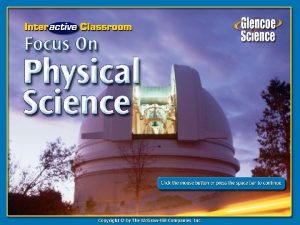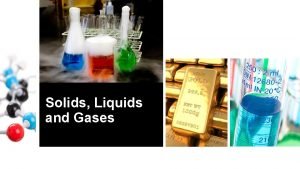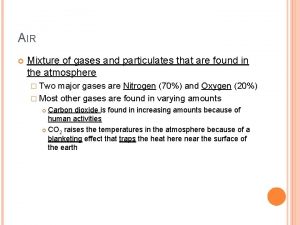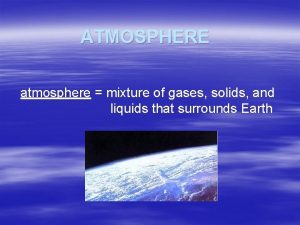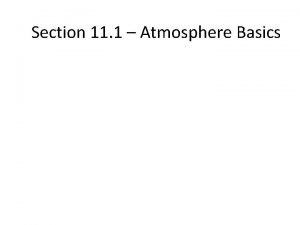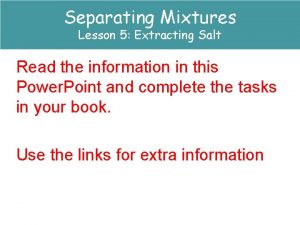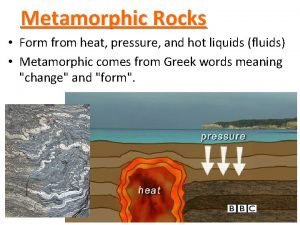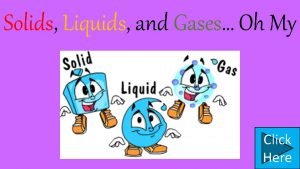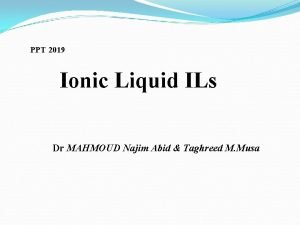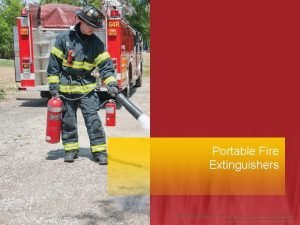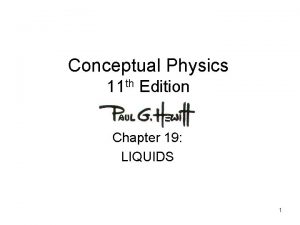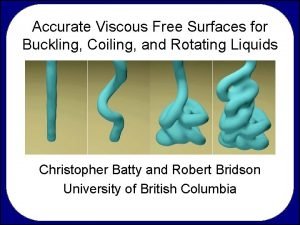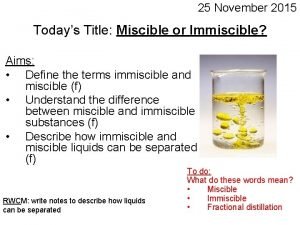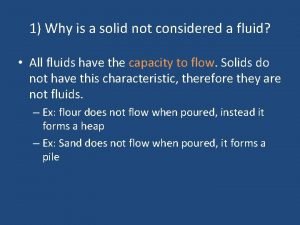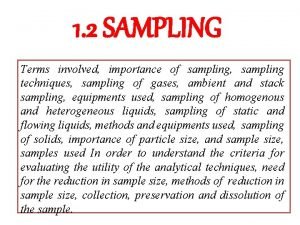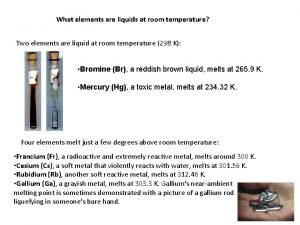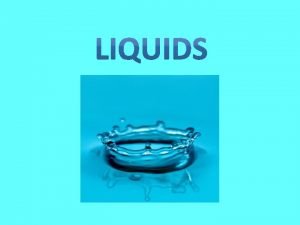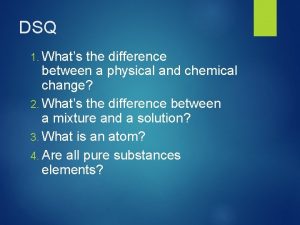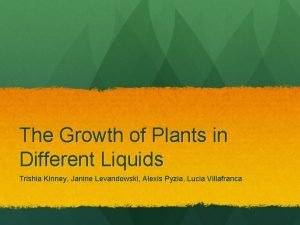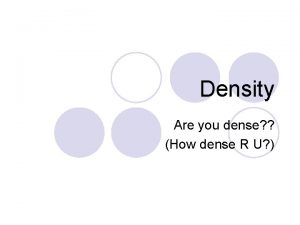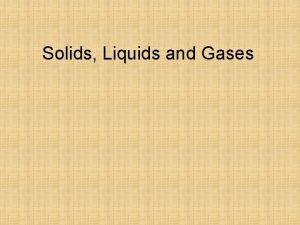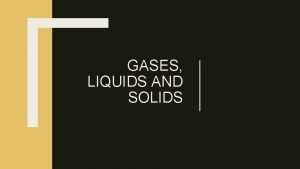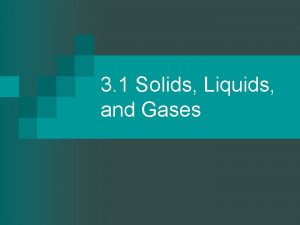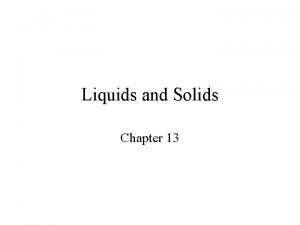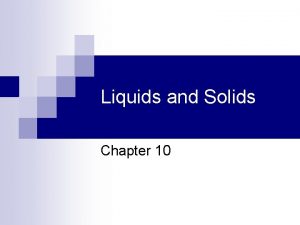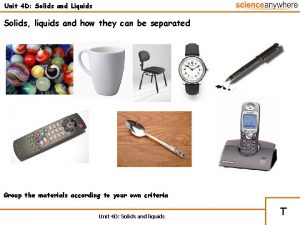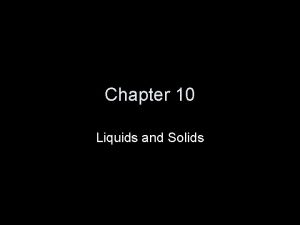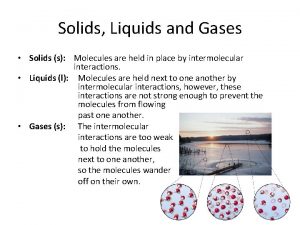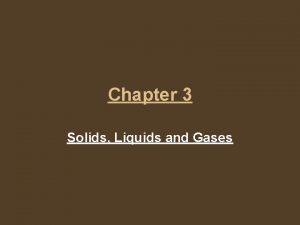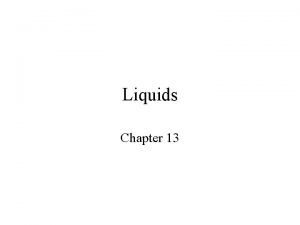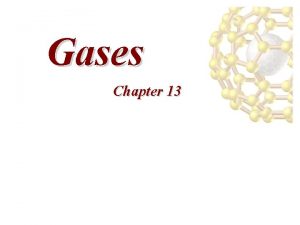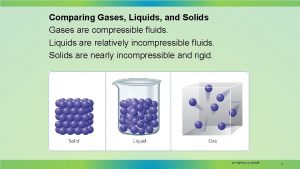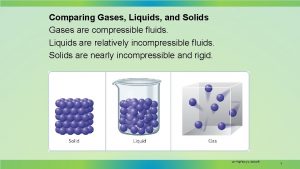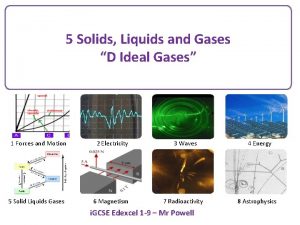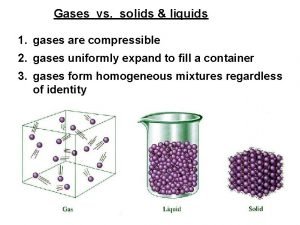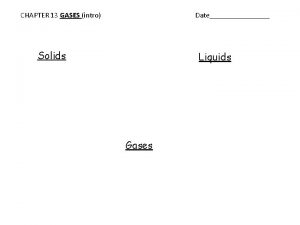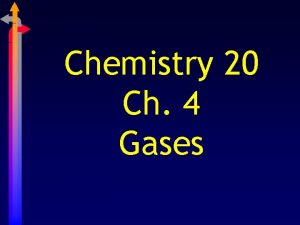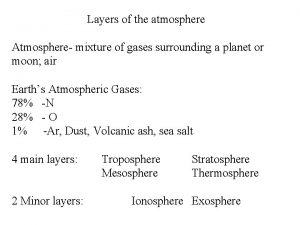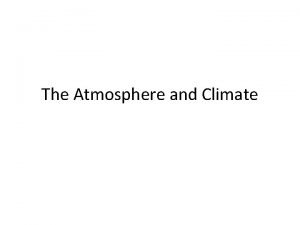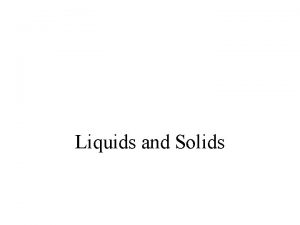ATMOSPHERE atmosphere mixture of gases solids and liquids
















































- Slides: 48

ATMOSPHERE atmosphere = mixture of gases, solids, and liquids that surrounds Earth

Composition of atmosphere: 1. 0 -4% water vapor: amount at any given time or place changes constantly a. percentage varies with seasons, altitude of particular mass of air, and surface features beneath air b. when volume is high percentages of other gases is slightly lower c. helps prevent heat loss from Earth d. added by evaporation and transpiration; removed by condensation and precipitation e. moist air → up to 4%; dry air → less than 1% f. exists in atmosphere in all three forms 1) gaseous form is source of clouds, rain, and snow 2) when changes from one state to another, heat is absorbed or released 3) affects atmospheric motions that create weather and climate

2. atmospheric dust, ice, & salt = three common solids found in atmosphere a. dust: 1) enters air by wind picking it up off ground and erodes it 2) includes mineral particles from soil, ash from fires, volcanic dust, microscopic organisms, meteor particles, tiny salt crystals 3) larger particles remain only briefly due to weight causing them to fall b. ice - in the form of hailstones and snow c. salt: picked up from ocean spray d. role in cloud formation

3. ozone layer = acts as a shield between people and harmful energy from sun a. ozone = form of oxygen with three atoms bonded together (O 3) b. absorbs most of the ultraviolet (UV) radiation that enters the atmosphere c. ultraviolet radiation = energy from the sun that can cause you to burn 1) too much causes skin cancer 2) also causes other health problems for plants and animals d. if ozone disappeared: 1) number of people dying from skin cancer would increase 2) could destroy most plants e. has become thinner all over world

4. 21% oxygen a. amount is result of natural processes that maintain chemical balance b. used/removed by: animals, bacteria, plants, forest fires, burning of fuels, weathering of rocks c. added by land ocean plants 1) released as product of photosynthesis d. second most abundant gas e. needed by most life forms

5. 78% nitrogen a. amount maintained by nitrogen cycle b. removed by nitrogen-fixing bacteria in soil on roots of certain plants c. added by process of denitrificaton during decay of dead organisms d. most abundant gas e. living things (plants and animals) use this to make protein 6. 1% other gases (argon, carbon dioxide, neon, helium, etc. ) 7. other components = liquids (most common = water)

Structure of the Atmosphere (divided into layers according to major changes in temperature) 1. troposphere = closest layer to the ground a. contains 75% of all atmospheric gases, as well as dust, ice, and liquid water b. most active portion of atmosphere because weather, clouds, and smog occur c. temperature decreases as altitude increases 1) decreases at average rate of 6. 5 o. C/km 2) stops decreasing at average altitude of 10 km d. tropopause = upper boundary of troposphere (varies around 9 – 16 km above surface) 1) altitude is not constant - changes with latitude and seasons of year 2) temperature does not change here = isothermal layer 3) ceiling to weather zone

2. stratosphere = lies above troposphere a. extends upward to altitude of 50 km b. temperature increases as altitude increases 1) base is ~ -60 o. C 2) warmer at upper boundary = stratopause (about 50 km above surface) 3) forms another isothermal layer c. contains ozone layer d. clear and dry with strong, steady winds and few weather changes e. jet streams make up lower portion

3. mesosphere = above stratosphere a. extends to an altitude of ~ 80 km b. temperature decreases as altitude increases 1) upper region has coldest zone of atmosphere; drops to -90 o. C 2) get another isothermal layer at upper boundary = mesopause c. helps protect Earth from meteoroids → may see streaks of light = “shooting” stars 4. thermosphere = above mesosphere a. temperature increases steadily with altitude 1) due to absorption of energy from the sun 2) can be more than 1000 o. C in areas b. air is very thin

c. has two parts: 1) ionosphere = lower portion a) altitude of 80 km to 550 km b) layer of electrically charged particles (ions and free electrons) c) important in radio communications 1] AM radio waves can be bounced off layer allowing great distances to be covered 2] if ions increase then cause interference d) area where the auroras are produced 2) exosphere = upper portion a) zone of indefinite altitude b) very few particles in air c) gases can escape to space d) outer layers from Van Allen Belts e) artificial satellites orbit Earth in this area

SOLAR ENERGY AND ATMOSPHERE 1. sun is source of all energy 2. radiation = transfer of energy through space by visible light, ultraviolet radiation, and other forms of electromagnetic waves a. can travel at speeds of 300, 000 km/s b. wavelength = distance from one wave crest to next 1) types differ in wavelength c. electromagnetic waves = make up all forms of radiation d. electromagnetic spectrum = complete range of wavelengths e. produced by all substances that have temperatures above absolute zero f. almost all shorter wavelengths absorbed in upper atmosphere

2. scattering = water droplets and dust suspended in atmosphere reflect and bend rays a. clouds, dust, and gas molecules affect path of radiation from sun b. sends rays out in all directions without changing wavelength c. send some back into space d. makes sky appear blue and sun appears red at sunrise and sunset

3. reflection: a. atmosphere is heated from Earth’s surface outward. b. sun - source of all energy in our atmosphere c. energy Earth receives: 1) 35% reflected back to space by clouds, Earth’s surface, and atmosphere 2) 15% absorbed by atmosphere 3) 50% absorbed by surfaces * balance among these determine characteristics of atmosphere and life that it supports d. albedo = fraction of solar radiation reflected by particular surface 1) energy reflected back without being absorbed by Earth’s system 2) earth = 0. 3 (30% reflected or scattered)

4. absorption: a. part is infrared rays and visible light b. absorbed by rocks, soil, water, and other earth materials c. greenhouse effect = atmosphere traps infrared rays over earth’s surface 1) absorb long wavelength infrared rays by gas molecules 2) lower atmosphere becomes warmer making surface warmer 3) objects re-emit some in changed form which prevents it from leaving atmosphere back to space 4) measurements show amount of carbon dioxide has been increasing in recent years

5. variations in temperature a. earth not heated equally at all places all the time b. warmth of atmosphere determined by: 1) latitude a) average temperature higher near equator than poles b) direct rays heat more effectively than slanting rays c. elevation 1) high elevations cool quickly at night 2) thinner air has less water vapor and CO 2 to trap heat d. water temperature changes less than land temperature 1) releases heat slower than land 2) winds off ocean have more moderate temperature than those off land e. delay in heating of atmosphere both seasonally and daily 1) warmest time of year – July 2) warmest time of day - ~2: 00 in afternoon

conduction = transfer of energy that occurs when molecules bump into one another 1. energy moves from fast moving molecules to slow moving molecules until all move at same rate 2. actual contact of molecules Ex: warm cup in your hand 3. only affects very thin atmospheric layer near Earth’s surface

convection = transfer of heat that occurs because of density differences in air 1. warmed air causes molecules to move apart, increasing volume and decreasing density 2. cold air has lower volume and higher density 3. warm air will rise when cold air moves in and pushes it up 4. constant exchange of cold/warm produces a convection current (wind) 5. atmospheric pressure generally lower beneath a warm air mass 6. main mechanism responsible for vertical motions of air which cause different types of weather

Temperature vs. Heat 1. temperature = how rapidly or slowly molecules move around a. more molecules or faster-moving molecules in given space creates higher temperature b. slow moving molecules cause substance to cool c. used to measure and interpret flow of energy 2. heat = transfer of energy that occurs because of a difference in temperature between substances a. direction of heat flow depends on temperature b. flows from object of higher temperature to object of lower temperature c. fuels atmospheric processes

Heat Energy: 1. when added to ice molecules move more rapidly changing position creating a liquid (melting) 2. when liquid is heated molecules move even faster changing position creating a gas (evaporation) 3. sublimation = solid changes directly into a gas without becoming a liquid a. air dry, temperature below freezing → ice change to water vapor b. deposition = water vapor changes directly to solid without becoming a liquid Ex: frost formation 4. water absorbs heat energy from sun a. causes molecules to evaporate and pass into air b. takes place in areas near the equator c. principal source is ocean

Atmospheric Measurements: dew point = temperature at which air is saturated and condensation takes place 1. often called condensation temperature 2. more water vapor the air starts with, higher its dew point 3. temperature of air will drop more slowly after reaching dew point 4. also forms clouds and fog 5. dew = water vapor condensed on surfaces in form of liquid 6. frost = temperature below freezing water vapor sublimes to a solid a. not frozen dew (clear beads of ice - not common) b. indicates temperature is low enough to damage growing plants

Vertical temperature changes: 1. adiabatic temperature changes = result solely from expansion or compression of air a. air mass will cool off by about 10 o. C for every 1000 m increase in altitude; moisture influences rate b. dry adiabatic lapse rate = rate at which unsaturated air to which no heat is added or removed will cool c. moist adiabatic lapse rate = rate at which saturated air cools 1) above LCL air becomes saturated and cools more slowly 2) rate ranges from ~ 4 o. C/1000 m in very warm air to almost 9 o. C/1000 m in very cold air

2. lifted condensation level (LCL) = height at which condensation occurs a. clouds form when water vapor condenses into water droplets b. often corresponds to base of clouds c. further condensation allows cloud to expand above

atmospheric pressure = ratio of weight of air to area of surface on which it presses 1. force of air pushing against surface due to weight of gas molecules and gravity 2. greatest at sea level and decreases as you move out toward space a. 99% of total mass of gases found within 32 km of surface b. remaining 1% extend upward hundreds of kilometers 1) gets thinner at higher altitudes 2) lower pressure at higher altitudes

3. standard sea level pressure = average weight is 14. 7 lbs/in 2 (15 lbs/in 2) or 10. 1 N/cm 2 4. varies at different places due to differences in air’s density 5. cold air more dense than warm air therefore higher pressure a. temperature is directly proportional to pressure b. temperature is inversely proportional to density → air rises as increase in temperature

6. acts in all directions always pushing down on us Ex: hand a. measures 8” X 4” = 32 in 2 X 15 lbs/in 2 = 480 lbs. pressure * don’t feel because hand pushes back as much as atmospheric pressure pushes down b. pressure pushes on body in all places but internal body pressure equalizes external pressure If there was no external body pressure → body would explode!!

temperature inversion = increase in temperature with height in atmospheric layer 1. temperature-altitude relationship is inverted 2. causes: a. rapid cooling of land on cold, clear, winter night when wind is calm b. warm air traps cooler air near earth’s surface 3. worsen air pollution problems by trapping pollution under inversion layer

wind = rush of air formed by imbalance between warm, less dense air mass and cool, more dense air mass 1. cool air, being more dense, sinks & forces warm, less denser air upward 2. for lower atmosphere, generally moves from areas of high density to areas of low density 3. response to imbalances created by unequal heating and cooling of Earth’s surface 4. will create areas of high and low pressure 5. usually measured in miles/hour or km/h; ships measure in knots; 1 knot = 1. 85 km/h

humidity = amount of water vapor in air 1. depends on temperature of air a. cooler air → molecules close → less space for water vapor → squeezed out b. warmer air → molecules move apart → hold more water vapor 2. warm air holds more moisture than an equal volume of cold air - as temperature increases the amount of moisture holds increases 3. saturated = air is holding all the moisture it can at a given temperature RH = 100%

relative humidity (RH) = amount of water vapor in air compared to maximum amount of water vapor air can hold at that temperature (its capacity) 1. stated as a percent 2. varies with temperature 3. calculated by dividing humidity by the capacity humidity X 100 capacity Ex: humidity = 11 capacity = 22 RH = 11 X 100 = 0. 50 X 100 = 50% 22 4. changes occur when: a. air at fixed temperature, changes as moisture enters or leaves air b. amount of moisture in air remains same, temperature of air changes

specific humidity = actual amount of moisture in air 1. number of grams of water vapor in 1 kg of air 2. measured only in units of mass 3. not affected by changes in temperature or pressure 4. only a change in the amount of water vapor in air can cause a change

clouds = visible masses of tiny water or ice particles suspended in atmosphere 1. due to condensation of water vapor throughout large volume of air 2. formation caused by: a. condensation nulcei = solid matter that provides surfaces for water condensation b. orographic lifting = formation of cloud when wind encounters a mountain and air has no place to go but up c. collision of air masses of different temperatures 3. process: a. lifted air cools → can’t hold moisture so it condenses out → cloud b. where air lifts will also have air descending which warms → clouds re-evaporates

4. amount of water vapor air can hold decreases as temperature goes down 5. stability = ability of air mass to resist rising (cooling) a. rate at which air mass cools partially depends on temperature of surface below it b. also affected by temperature of surrounding air masses and temperature of air mass itself c. will become unstable if cooler than surface beneath it 6. latent heat = energy absorbed & stored in water vapor a. released when water condenses b. also involved when water freezes or thaws c. can provide energy to weather systems

7. cooling leads to condensation a. convective cooling = lowering of temperature of mass of air due to it rising and expanding 1) compression warms air 2) expansion cools air b. forced upward movement of air 1) moving air mass meets sloping terrain 2) storms events c. temperature changes due to one body of moist air mixing with another at different temperature d. advective cooling = when wind carries warm, moist air across cold ocean or region of land

Classification of Clouds 1. shape of a cloud depends on air movement that forms it 2. classified according to shape and altitude 3. reach higher altitudes in equatorial areas and lower altitudes in polar areas 4. heights are measured above surface, not above sea level 5. forms: stratus, cumulus, cirrus, and nimbus 6. altitude groups: low (up to 2000 m), middle (2000 - 6000 m), and high (above 6000 m)

Basic Types of Clouds: 1. stratus = low sheets or layers of clouds a. form where layer of warm, moist air lies above a layer of cool air b. smooth, gray clouds that cover the whole sky and block out the sun c. form at altitude of about 2. 5 km d. usually longer than they are thick e. associated with light rain and drizzle

f. nimbostratus = thick, dark, gray layers 1) associated with steady, long precipitation (heavy rains/snows) 2) blocks out sun g. altostratus = form at middle altitudes 1) thinner, can be either all liquid or mixture of liquid and ice crystals 2) dark, but sometimes produce precipitation

2. cumulus = puffy, vertical growing clouds a. form when warm, moist air rises and cools b. by vertically rising air currents c. at altitudes of 2. 4 to 13. 5 km d. may extend vertically e. height depends on speed of upward movement and amount of moisture in air f. develop during the day over land g. usually associated with fair weather

h. cumulonimbus = thunderheads 1) get larger and darker on bottom 2) become dark gray with ragged edges 3) associated with thunderstorms, heavy rain, and hail i. altocumulus = middle altitudes 1) can be either all liquid or mixture of liquid & ice crystals 2) resemble white fish scales j. stratocumulus = low clouds which are combination of stratus and cumulus cumulonimbus stratocumulus

3. cirrus = feathery or fibrous clouds a. form at very high altitudes between 6 - 12 km b. composed of ice crystals or supercooled water c. can see in fair weather; sunlight passes through easily d. cirrocumulus = composed entirely of ice crystals 1) often appear before rain or snow falls 2) form quite rarely

e. cirrostratus = long and thin 1) form continuous layer that sometimes covers sky 2) vary in thickness from being almost transparent to dense enough to block sun or moon 3) may cause halo effect around sun or moon due to ice crystals bending light 4) may thicken and lower base to form altostratus clouds

fog = result of condensation of water vapor in air 1. forms near surface when air close to ground is cooled 2. usually a form of stratus cloud 3. radiation fog = layer of air in contact with earth becomes chilled at night below its dew point a. results from lose of heat by radiation b. also called ground fog c. usually forms on calm, clear nights d. thickest in valleys and low places

4. advection fog = form when warm moist air moves across cold surface a. common along coasts b. may form over ocean 5. upslope fog = formed by lifting and adiabatic cooling of air as it rises along land surfaces 6. steam fog = forms over rivers and lakes a. shallow layer b. cool air moves over warm body of water

precipitation = any moisture that falls from air to earth’s surface 1. can have different forms depending on the temperature of the air the water passes through 2. four main types: a. rain = liquid precipitation 1) large drops of water that are far apart and fall fast 2) diameter between 0. 5 mm and 5 mm 3) drizzle = very fine drops that are very close together and fall very slowly a) diameter smaller than 0. 5 mm b) small amount of total precipitation 4) vary from fine mist to torrential down pours

b. snow = solid precipitation 1) when water vapor changes directly to a solid 2) air temperature must be below freezing 3) may fall as small pellets, individual crystals, or snowflakes 4) diameter ranges from several mm to several cm 5) small at low temperatures and larger at temp. near 0 o. C 6) size difference due to amount of moisture in air

c. sleet = clear ice pellets 1) form when rain falls through layer of freezing air 2) usually smaller than 0. 3 inches in diameter 3) glaze ice = thick layer of sheet ice a) rain does not freeze until strikes surface near ground b) weight often breaks tree limbs and power lines c) conditions that create are called ice storms 4) freezing rain = supercooled drops turn into ice when come in contact with ice nucleus or something solid 5) freezing drizzle = smaller supercooled drops sleet

d. hail = solid precipitation in form of lumps of ice 1) drops of water freeze in layers around a small nucleus of ice 2) usually formed in cumulonimbus clouds 3) can range from 5 to 75 mm in diameter 4) grow larger as they are tossed up and down by rising and falling air currents 5) falls when it grows too heavy for the updraft to continue holding it up 6) can grow larger than a softball

Causes of Precipitation: 1. cloud droplet must increase size 100 X normal diameter 2. coalescence = combination of different sized cloud droplets to form larger droplets a. when too heavy to be supported by air, droplet falls 3. supercooling = water droplets are induced to remain liquid at temperatures below 0 o. C a. droplets have temperature less than 0 o. C b. too few freezing nuclei present c. freezing nuclei = condensation nuclei with crystalline structure like that of ice 1) needed for ice crystals to form 2) increase in size until gain enough mass to fall

4. cloud seeding = method used to attempt to cause or increase precipitation a. freezing nuclei are added to supercooled clouds b. methods used: 1) silver iodide crystals 2) powdered dry ice c. may increase precipitation from some clouds and not others d. uses: 1) overcome droughts 2) control severe storms
 Thermal expansion and contraction examples
Thermal expansion and contraction examples Solids liquids and gases section 2 properties of fluids
Solids liquids and gases section 2 properties of fluids Venn diagram matter
Venn diagram matter 20 examples of liquids
20 examples of liquids Examples of solids liquids and gases pictures
Examples of solids liquids and gases pictures Lesson 1 thermal energy and the behavior of matter
Lesson 1 thermal energy and the behavior of matter Chapter 14 solids liquids and gases worksheet answers
Chapter 14 solids liquids and gases worksheet answers Chapter 14 solids liquids and gases
Chapter 14 solids liquids and gases Particle movement in solids liquids and gases
Particle movement in solids liquids and gases How does sound travel through solids liquids and gases
How does sound travel through solids liquids and gases Properties of solids liquids and gases
Properties of solids liquids and gases Motion of particles in solids, liquids and gases
Motion of particles in solids, liquids and gases Why are gases easier to compress than solids or liquids
Why are gases easier to compress than solids or liquids Atmosphere is a mixture of gases
Atmosphere is a mixture of gases Molecules of solid liquid and gas
Molecules of solid liquid and gas Adhesive force
Adhesive force Liquids and solids menu
Liquids and solids menu Liquids and solids
Liquids and solids Chapter 11 - states of matter: liquids and solids
Chapter 11 - states of matter: liquids and solids Molecular theory of gases and liquids
Molecular theory of gases and liquids A yolk and cream mixture that is used to thicken liquids
A yolk and cream mixture that is used to thicken liquids Theory of filtration
Theory of filtration Is 14 karat gold homogeneous or heterogeneous
Is 14 karat gold homogeneous or heterogeneous Air mixture of gases
Air mixture of gases Solids in the atmosphere
Solids in the atmosphere Gases on earth's atmosphere
Gases on earth's atmosphere Nourishing element of stock
Nourishing element of stock Breakdown in liquid
Breakdown in liquid Separates liquids of different colours
Separates liquids of different colours Rocks changed by temperature pressure and hot liquids
Rocks changed by temperature pressure and hot liquids Liquid state of matter properties
Liquid state of matter properties What are solids
What are solids Ionic liquids green chemistry ppt
Ionic liquids green chemistry ppt Fire extinguisher basics
Fire extinguisher basics Phonetics ch
Phonetics ch Solutions are monophasic or biphasic
Solutions are monophasic or biphasic Liquid in baking
Liquid in baking Pull examples
Pull examples Compressible and incompressible fluids
Compressible and incompressible fluids Viscosity of liquids
Viscosity of liquids What does immiscible mean
What does immiscible mean Why are liquids incompressible
Why are liquids incompressible Long pile and alternate shovel method
Long pile and alternate shovel method Two elements that are liquid at room temperature
Two elements that are liquid at room temperature Kinetic molecular theory of liquids
Kinetic molecular theory of liquids Whats a physical change
Whats a physical change Plant growth with different liquids
Plant growth with different liquids Dense liquids
Dense liquids Water countable or uncountable
Water countable or uncountable
















